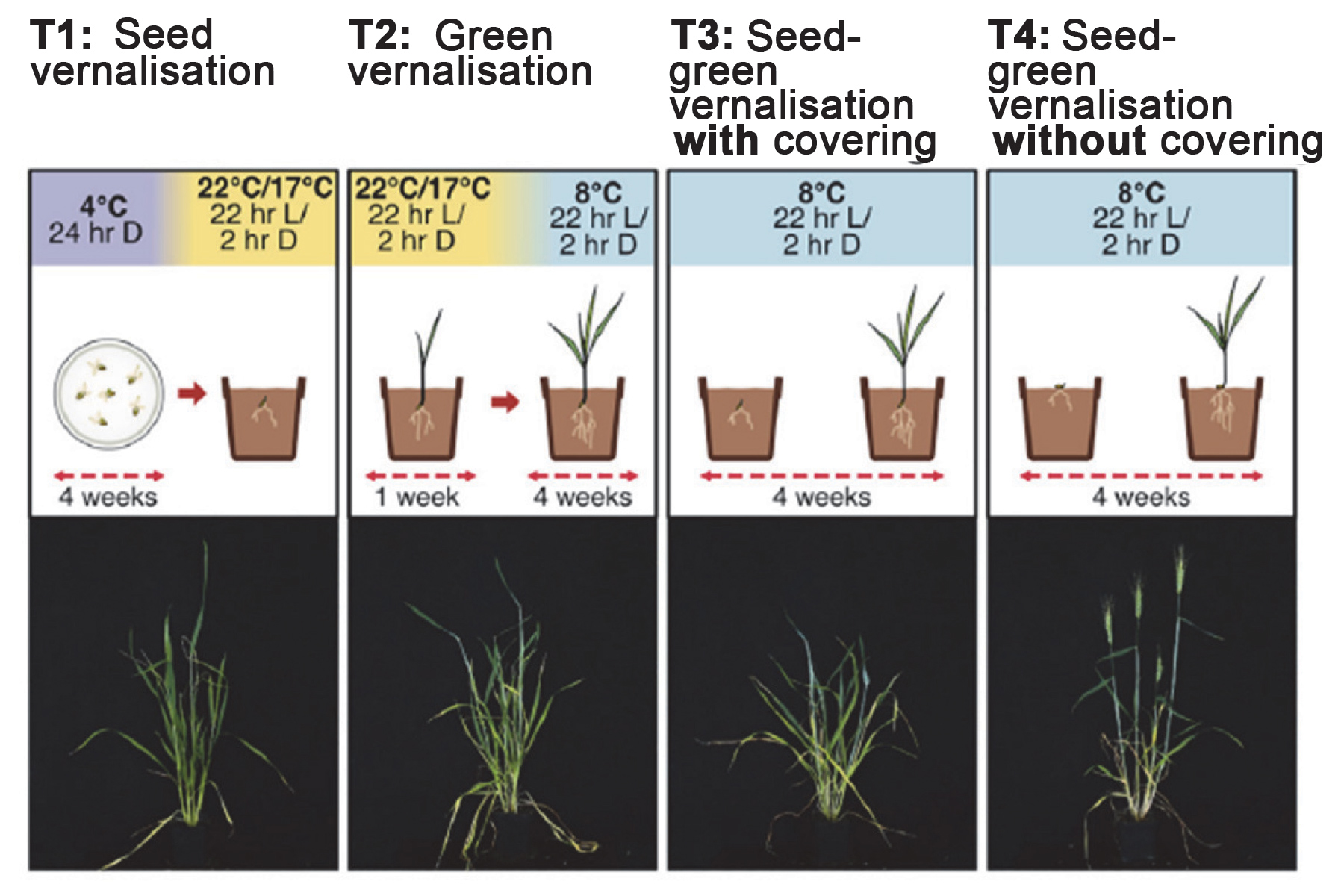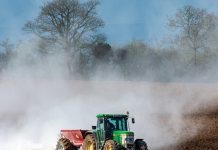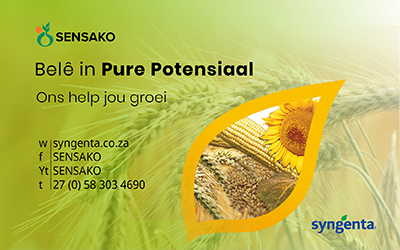
Winter wheat (Triticum aestivum L.) cultivars are classified as three types according to their quantitative vernalisation requirement to reach a vernalisation saturation point: weak winter (brief cold exposure needed), semi winter (two to four weeks cold exposure needed) and strong winter (four to six weeks cold exposure needed). The global mean temperature is projected to continue its increase by roughly 3 to 5 °C by the end of the 21st century, which will influence the reaching of a vernalisation saturation point.
This can lead to a stagnation of winter wheat breeding for yield or a drastic reduction in yield of cultivars or breeding lines of a semi winter to strong winter type. Various parameters, including type, intensity and duration of vernalisation, crop genotype and growth stage, as well as plant hormones affect the process of vernalisation.
Vernalisation is the process whereby blossoming is advanced by a cold treatment given to an utterly hydrated seed or a developing plant. Suitable temperatures for the period of vernalisation are between 2 to 8 °C. The regulation of phasic growth and acclimatisation of wheat to specific environments are made possible mainly due to the allelic variations of vernalisation-1 (VRN1) and photoperiod-1 (PPD1) genes. After the vernalisation requirement is met, photoperiod response will regulate the flowering timing, which is predominantly mediated by photoperiod genes.
Before the plant is exposed to cold stress, the flowering promoter gene (FT) is repressed by the long-day flowering repressor gene (VRN2). Cold stress increases the expression of a central integrator of the vernalisation-accelerated flowering gene (VRN1). As a result VRN2 is repressed, leading to the activation of FT during the long days and subsequent induction of flowering (Figure 1). If the VRN2 gene is inactivated or removed, wheat genotypes are produced, which can advance to the flowering period without requiring the process of vernalisation.

Research has indicated that each degree increase of temperature results in the reduction of wheat production by 6%. Higher temperatures affect winter crop growth and consequent grain filling (e.g., high temperatures induce shortening of reproductive phases and reduced light interception over the shortened life cycle). Climate warming during recent decades has shown great seasonal asymmetry, with much higher warming rates in winter and spring. Winter and spring warming could potentially change the process of vernalisation fulfilment (i.e., effective chilling accumulation before anthesis).
Variations in vernalisation fulfilment affect the number of leaves and tillers, plant height, flag leaf area, floral initiation time, flowering phenology, spikelet formation, and spike fertility and thus contribute indirectly to winter crop yields. Warmer temperatures during the vernalisation period could slow the chilling accumulation and thus delay onset of the reproductive stage. The delay in the onset of the reproductive stage potentially increases the risk of high temperature exposure for winter wheat during anthesis and consequent grain filling. This can lead to lower harvestable yields, higher yield variability, and reduction in suitable areas for winter wheat cultivation. On the other hand, sufficient vernalisation fulfilment before anthesis could partially compensate for the adverse effect of global warming on winter wheat heat stress.
Different alleles of VRN1 and PPD1 genes lead to different cold needs and must be exploited by winter wheat breeders. The allelic differences of VRN1 and PPD1 are mainly from mutations either in the coding regions or the promotor regions of those loci, which resulted in opposite effects, such as Ppd-D1b for photoperiod-sensitive (long-day) or Ppd-D1a for photoperiod-insensitive (day-neutral) phenotypes. The distribution of VRN1 and PPD1 allelic variants has been discovered to vary across continents, countries, and regions, with some haplotypes inadequately represented or absent in certain geographic areas.
This implies that different regions require different VRN1 and PPD1 combinations to meet local production conditions. Breeders use the combinations of VRN1 and PPD1 allelic variants to modify crop phenology so that sensitive developmental phases take place in more optimal conditions. Warmer winters will cause VRN1 mutations with less cold requirements to be selected by breeders in the future for variety development. Photoperiod-insensitive PPD1 alleles can cause an increase in yield thanks to their ability to avoid the sweltering summer heat and dryness due to earlier flowering. Gene markers were developed to direct breeding of semi winter and strong winter wheat cultivars to adapt to different geographical areas and changing climates.
Human cultivation management practices can also influence the vernalisation degree days (VDD), particularly the availability and levels of applied water and adaptive planting schemes. Irrigation is seldom applied to winter wheat; it is locally used to avoid drought stress throughout the whole growing season. The possible difference in cultivars planted in rainfed and irrigated croplands could also bias the sensitivity of winter wheat yields to changes in VDD.
Plant hormones can regulate different plant genetic and physiological activities in crop plants. It is possible to shorten vernalisation, using priming (seeds) and spraying (plants) treatments. The gibberellins (GA) can regulate different biological activities including germination, leaf development, stem elongation, and the initiation and development of reproductive organs. Derivatives of cytokinins, including kinetin and 6-benzyladenine (BA6), can suitably decrease the period of vernalisation under controlled conditions.
Priming or spraying winter wheat with a single or combined use of GA, kinetin and BA6 are suitable partial substitutes for vernalisation and can increase grain yield under arid and semi-arid conditions. Similar genetic and physiological activities during the vernalisation period are induced by the exogenous use of plant hormones or cold stratification. Gibberellins along with photoperiod and vernalisation are among the essential factors required for the flowering of winter wheat. In fact, such mechanisms result in the activation of floral meristem identity genes, which eventually result in the production of flowers in winter wheat by differentiating specific cells in the shoot apical meristem into flowers. This makes it possible to regulate the planting time of crop plants and avoid the negative effects of stress due to the shortening of the vernalisation period by using plant hormones. Seed priming causes the plant to become more tolerant under different conditions, including stress, by inducing the activation of different genes and signalling pathways.
Recent advances in speed breeding (SB) protocols have dramatically reduced generation time for many short-day and long-day species by optimising light and temperature conditions during plant growth. This technique made it possible for breeders to release cultivars over a shorter time. Speed green vernalisation (SGV) followed by SB gave the best results for the growing of winter wheat. SGV was done by placing germinated seeds on the soil surface at 8 °C for four weeks with 22-hour light:2-hour dark daytime. The plants were then transferred to SB (22-hour light:2-hour dark at 22 °C:17 °C) conditions to evaluate the time to flowering. These treatment conditions meet and reduce the vernalisation requirement and generation time for many winter wheat cultivars tested and are effective even on cultivars that traditionally have a longer vernalisation requirement (Figure 2).

 These experiments confirmed that 8 to 10 °C are the most efficient and reliable vernalisation temperatures. The SGV-SB makes early and more synchronous flowering across segregating or diverse germplasm possible and can facilitate more efficient crossing and rapid generation times. At least 25 seeds were harvested from each F5 plant by the research group using this method, which is sufficient to bulk seed in the field and perform subsequent evaluation. The developed protocol identified the environmental parameters that can be further modified to account for local or genotypic variation in vernalisation efficiencies and therefore offer a framework to universally reduce generation times in winter cereals.
These experiments confirmed that 8 to 10 °C are the most efficient and reliable vernalisation temperatures. The SGV-SB makes early and more synchronous flowering across segregating or diverse germplasm possible and can facilitate more efficient crossing and rapid generation times. At least 25 seeds were harvested from each F5 plant by the research group using this method, which is sufficient to bulk seed in the field and perform subsequent evaluation. The developed protocol identified the environmental parameters that can be further modified to account for local or genotypic variation in vernalisation efficiencies and therefore offer a framework to universally reduce generation times in winter cereals.
Source
- Milec Z, Strejckova B & Safar J. 2023. Contemplation on wheat vernalization. Front. Plant Sci. 13:1093792. Doi: 10.3389/fpls.2022.1093792
- Cha J-K, O’Connor K, Alahmad S, Lee J-H, Dinglasan E, Park H, Lee S-M, Hirsz D, Kwon S-W, Kwon Y, Kim K-M, Ko J-M, Hickey LT, Shin D & Dixon LE. 2022. Speed vernalization to accelerate generation advance in winter cereal crops. Mol. Plant. 15, 1300–1309. Doi: org/10.1016/j.molp.2022.06.012





























